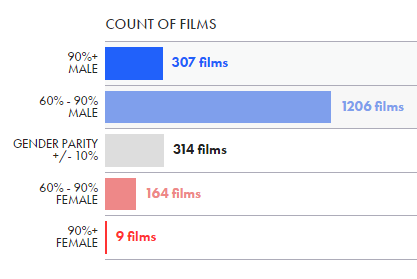A new project measures the gender balance in the dialogue of 2,000 movies.
By Lisa Wade
Filmgoers queueing to see Fritz Lang’s film Man Hunt outside the Roxy Theater at 153 West 50th Street at 7th Avenue in New York City, 1941. (Photo: Hulton Archive/Getty Images)
Polygraph’s Hanah Anderson and Matt Daniels undertook a massive analysis of the dialogue of approximately 2,000 films, counting those characters who spoke at least 100 words. With the data, they’ve producing a series of visuals that powerfully illustrate male dominance in the American film industry.
We’ve seen data like this before and it tells the same disturbing story: across the industry, whatever the sub-genre, men and their voices take center stage.

They have some other nice insights, too, like the silencing of women as they get older and the enhancing of men’s older voices.
But knowledge is power. My favorite thing about this project is that it enables any of us — absolutely anyone — to look up the gender imbalance in dialogue in any of those 2,000 movies. This means that you can know ahead of time how well women’s and men’s voices are represented and decide whether to watch. The dialogue in Adaptation, for example, is 70 percent male; Good Will Hunting, 85 percent male; The Revenant, 100 percent male.
We could even let the site choose the movies for us. Anderson and Daniels include a convenient dot graph that spans the breadth of inclusion, with each dot representing a movie. You can just click on the distribution that appeals to you and choose a movie from there. Clueless, Gosford Park, and The Wizard of Oz all come in at a perfect 50/50 split. Or, you can select a decade, genre, and gender balance and get suggestions.
Polygraph has enabled us to put our money where our principles are. If enough of us decide that we won’t buy any movie that tilts too far male, it would put pressure on filmmakers to make movies that better reflected real life. This data makes it possible to do just that.

||
This story originally appeared on Sociological Images, a Pacific Standard partner site, as “Database Enables Users to Choose Films Based on Gender Balance.”





